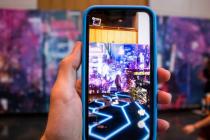UMD pioneers immersive media design major, merging computer science and art
The University of Maryland is debuting an immersive media design major this semester, the first undergraduate program in the country that synthesizes art with computer science.
There are two tracks available in the program: an art track leading to a bachelor’s of arts degree from the college of arts and humanities, and a computer science track leading to a bachelor’s of science degree from the college of computer, mathematical and natural sciences.
The program works with creating virtual and augmented realities, offering a wide variety of courses for whichever track a student wants to take.
One of the classes, Introduction to Immersive Media, covers history and research in the field. Its projects involve sensors, augmented reality and virtual reality.
Another class, Introduction to Computational Media, teaches students about the computing that’s required for each type of media. For example, imagery deals with computer graphics and sound deals with synthetic audio.
“We’re investigating ways to use modern technology and media to take the place of information that you would perceive with your senses in a natural environment,” said Stevens Miller, an adjunct lecturer in the department of computer science.
As a result, students can create artificial environments where they control interactions with the senses — sight, sound and even touch and smell in some cases.
Studio arts lecturer Mollye Bendell used the Artechouse, an art center in Washington, D.C., as an example of a virtual reality experience that uses immersive media design.
“[It’s] a gallery that specializes in the intersection of art and technology,” she said. “[An example is] an augmented reality application where you’re looking through the camera on your phone and … you see a 3D model appear.”
An immersive media design exhibit was held at The Clarice Smith Performing Arts Center as a part of NextNOW Fest in mid-September. About 15 students displayed their projects, Bendell said.
In one student’s project, people were able to play chess remotely with others around the world, Miller said.
“Instead of being limited to a two-dimensional point and click-with-your-mouse way of interacting with the chessboard, you actually saw a three-dimensional chess set in front of you that you could manipulate even though it doesn’t actually exist,” he added.
While all immersive design students need to have coding ability, the computer science track covers more of the technical components while the art track focuses on the perceptive side, Miller said.
Sophomore Maggie Letvin, a studio art major and hopeful immersive media design major, is planning on the art track. She’s used to approaching projects from the angle of an artist, and said that programming was hard for them.
“[With] programming, you have to know what you want to do ahead of time,” she said. “I approach art from a standpoint of, ‘I have the materials, I’m just gonna work with my hands and figure out what happens,’ but you can’t exactly do that with coding.”
In later years, students from the art track are paired with students from the computer science track. As a result, students are able to work with a partner from a different background and learn more from each other.





